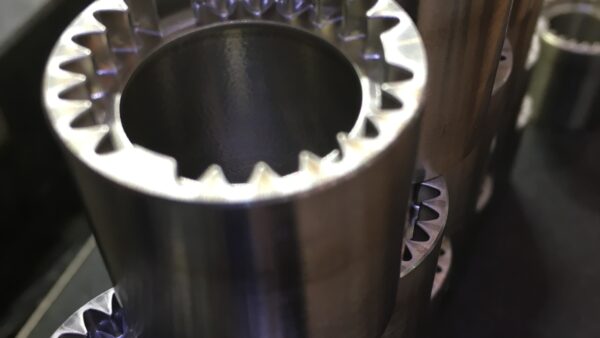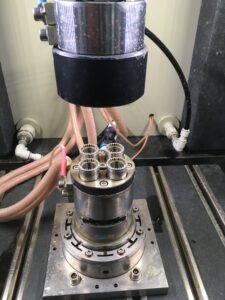Keep up with the news
NewsThe “P” makes the difference

PECM, the precise ECM
PEMTec at the EMO 2017, Hanover. At the international trade fair we exhibited our new machine, the PEM 800S. For demonstration purposes, we produced internal gears: four blanks were inserted into the device, the start button was pressed, the axis with flushing chamber and electrode was lowered onto the parts to be manufactured. For five minutes, depending on the background noise, a slight humming and a barely noticeable whistle could be heard. However, no chips flew, no electrolyte was injected.
The PEM 800S is barely visible to the audience and removes the metal electrochemically. After a short time, the axis moves upwards and the four internally toothed workpieces were finished. The result speaks for itself, the visitors were mostly amazed by the quality of the images and the shiny surface. The question arises immediately as to how the material removal and thus the technology works. From our experience we know that even ECM, i. e. electrochemical metal machining, is often unknown.
How does electrochemical metal machining work?
The ECM process is a defined removal method that is used to deburr, boil, polish or drill holes. Electrochemical processing requires two elementary components: electrolyte and electricity. The salt water conducts the electrical power and the liquid is called electrolyte. This is flushed into the processing gap, between electrode and workpiece, and the material is removed anodically by the switched-on current. The electrode is replicated inversely on the metal. This procedure is identical for ECM and PECM. The most important about the precision of electrochemical metalworking is the size of the working gap. With ECM, this is approximately 0.1 millimeters or greater. With the PECM, this is reduced to one hundredth of a millimeter (0.01 millimeter). The smaller the working gap, the more precise the accuracy.
Due to the very small distance between electrode and workpiece, the electrolyte can no longer flow sufficiently. By oscillating the vibrator and thereby the electrode, an upward movement is achieved before the actual processing cycle, so that the metal particles are removed and washed out. The PECM technology is characterized by the fact that the rinsing and ablation processes are constantly alternating and are superimposed from countersinking into the workpiece. Three-dimensional geometries can be introduced by this procedure. Accuracies in the range of up to 10 micrometers and surface qualities with an arithmetic roughness of up to 0.03 micrometers are achieved. As the electrode does not touch the workpiece and the material is removed at a maximum temperature of 40 degrees Celsius, there are no mechanical or thermal influences. This is what we call stress-free processing.
What is made with precise electrochemical machining?
We are absolutely convinced of the technology and are a little proud that our machines are capable of producing phenomenal parts. Pemmed products win races, fly into space and back again, or fly in airplanes from continent to continent. Products produced with PEMTec machines can sometimes be collector’s items and also serve human health. And the internal gearing shown in Hanover can be a step into a new future of e-mobility.

